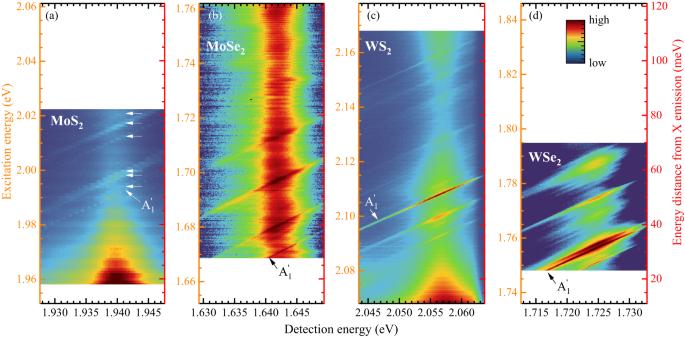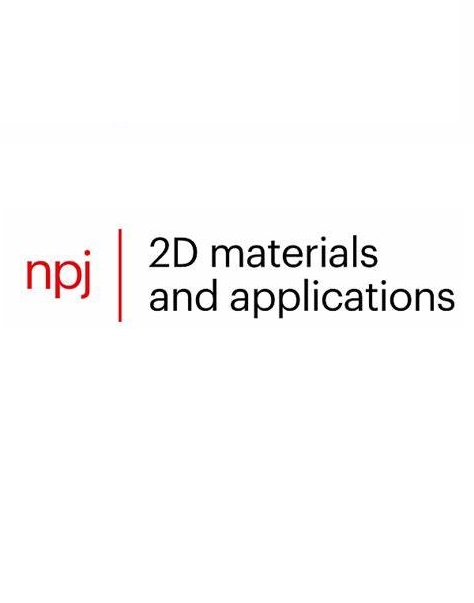Raman scattering excitation in monolayers of semiconducting transition metal dichalcogenides
IF 8.8
2区 材料科学
Q1 MATERIALS SCIENCE, MULTIDISCIPLINARY
引用次数: 0
Abstract
Raman scattering excitation (RSE) is an experimental technique in which the spectrum is made up by sweeping the excitation energy when the detection energy is fixed. We study the low-temperature (T = 5 K) RSE spectra measured on four high quality monolayers (ML) of semiconducting transition metal dichalcogenides (S-TMDs), i.e. MoS2, MoSe2, WS2, and WSe2, encapsulated in hexagonal BN. The outgoing resonant conditions of Raman scattering reveal an extraordinary intensity enhancement of the phonon modes, which results in extremely rich RSE spectra. The obtained spectra are composed not only of Raman-active peaks, i.e. in-plane E $${}^{{\prime} }$$ and out-of-plane A $${}_{1}^{{\prime} }$$ , but the appearance of 1st, 2nd, and higher-order phonon modes is recognized. The intensity profiles of the A $${}_{1}^{{\prime} }$$ modes in the investigated MLs resemble the emissions due to neutral excitons measured in the corresponding PL spectra for the outgoing type of resonant Raman scattering conditions. Furthermore, for the WSe2 ML, the A $${}_{1}^{{\prime} }$$ mode was observed when the incoming light was in resonance with the neutral exciton line. The strength of the exciton-phonon coupling (EPC) in S-TMD MLs strongly depends on the type of their ground excitonic state, i.e. bright or dark, resulting in different shapes of the RSE spectra. Our results demonstrate that RSE spectroscopy is a powerful technique for studying EPC in S-TMD MLs.

半导体过渡金属二卤化物单层中的拉曼散射激发
拉曼散射激发(RSE)是一种在探测能量固定的情况下通过扫描激发能量来构成光谱的实验技术。我们研究了封装在六方 BN 中的四种高质量过渡金属二钙化物(S-TMDs)单层(ML)(即 MoS2、MoSe2、WS2 和 WSe2)的低温(T = 5 K)RSE 光谱。拉曼散射的外向共振条件显示了声子模式的非凡强度增强,从而产生了极其丰富的 RSE 光谱。所获得的光谱不仅由拉曼活性峰(即面内 E ${}^{\prime} }$$和面外 A ${}_{1}^{\prime} }$$)组成,而且出现了一阶、二阶和更高阶的声子模式。在所研究的 ML 中,A $${}_{1}^{{\prime} }$ 模式的强度曲线类似于在相应的出射型共振拉曼散射条件下的聚光光谱中测量到的中性激子发射。此外,对于 WSe2 ML,当入射光与中性激子线共振时,观察到 A $${}_{1}^{\{prime} }$$ 模式。S-TMD ML 中激子-声子耦合(EPC)的强度在很大程度上取决于其地面激子态的类型,即亮态或暗态,从而导致 RSE 光谱的不同形状。我们的研究结果表明,RSE 光谱是研究 S-TMD ML 中 EPC 的一种强大技术。
本文章由计算机程序翻译,如有差异,请以英文原文为准。
求助全文
约1分钟内获得全文
求助全文
来源期刊

npj 2D Materials and Applications
Engineering-Mechanics of Materials
CiteScore
14.50
自引率
2.10%
发文量
80
审稿时长
15 weeks
期刊介绍:
npj 2D Materials and Applications publishes papers on the fundamental behavior, synthesis, properties and applications of existing and emerging 2D materials. By selecting papers with the potential for impact, the journal aims to facilitate the transfer of the research of 2D materials into wide-ranging applications.
 求助内容:
求助内容: 应助结果提醒方式:
应助结果提醒方式:


